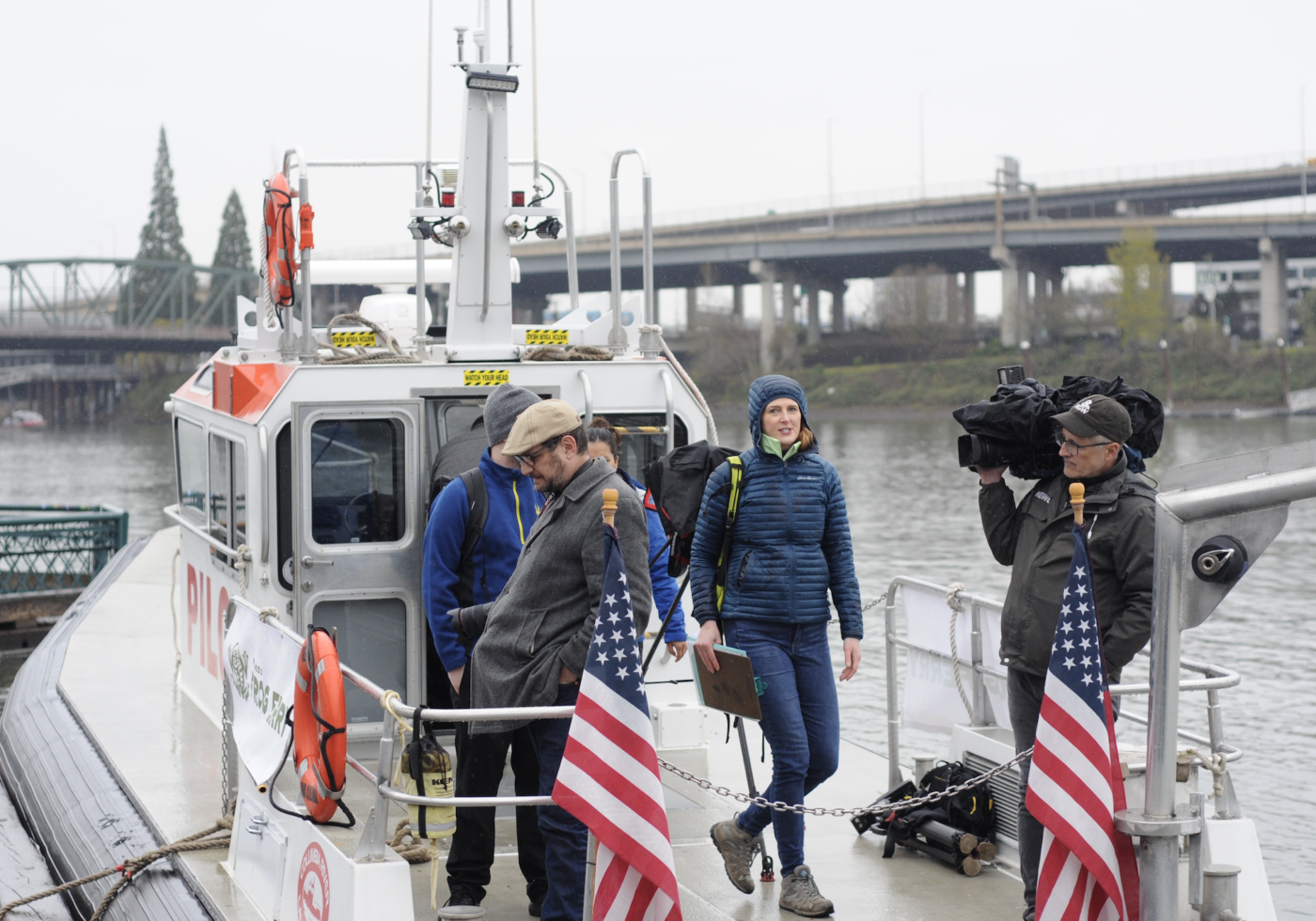
I’ve used all kinds of modes of transportation to get around Portland: bus, MAX, streetcar, car, bike, scooter, aerial tram, my own two feet. And now I can add boat to that list.
On Thursday morning, I accompanied Friends of Frog Ferry (FOFF) for their River Run event, which was intended to give attendees the experience of being aboard a Portland ferry en route between St. Johns and the South Waterfront. While the vessels we rode were small pilot boats that aren’t necessarily representative of what the ferries would look like, the experience provided a good sense of what it’s like to use the Willamette River as a transportation route, which is what the Frog Ferry advocates want Portlanders to embrace.
The event began with a press conference at RiverPlace Marina, where FOFF president and founder Susan Bladholm and board member Nina Byrd spoke about why Portland needs a ferry service. Due to the different (potentially more pro-ferry) mood in City Hall, the tone at this press conference was less politically charged than the one Bladholm held last April. The message, however, remains the same: FOFF needs the city’s support so they can access federal grants for ferry services.

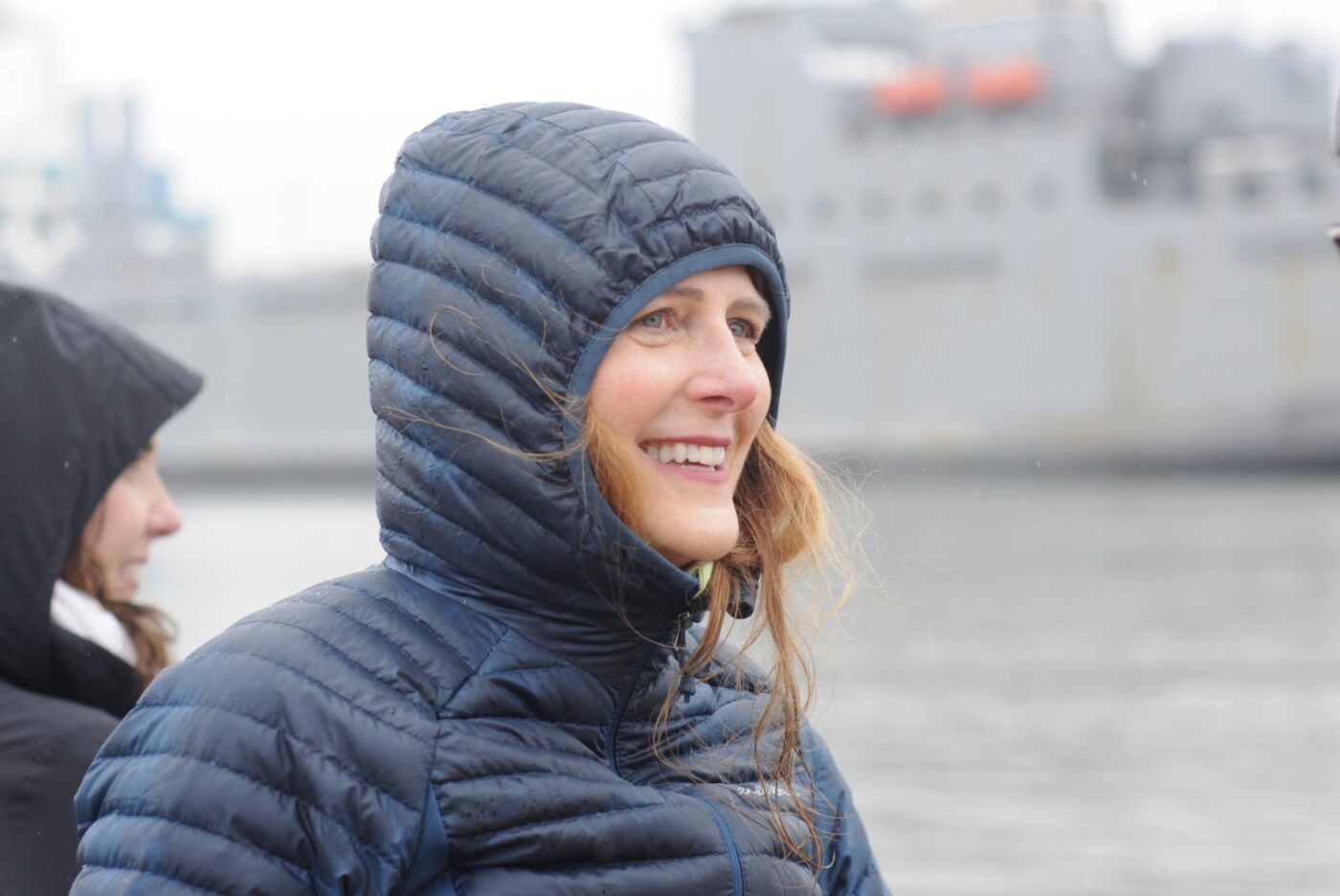
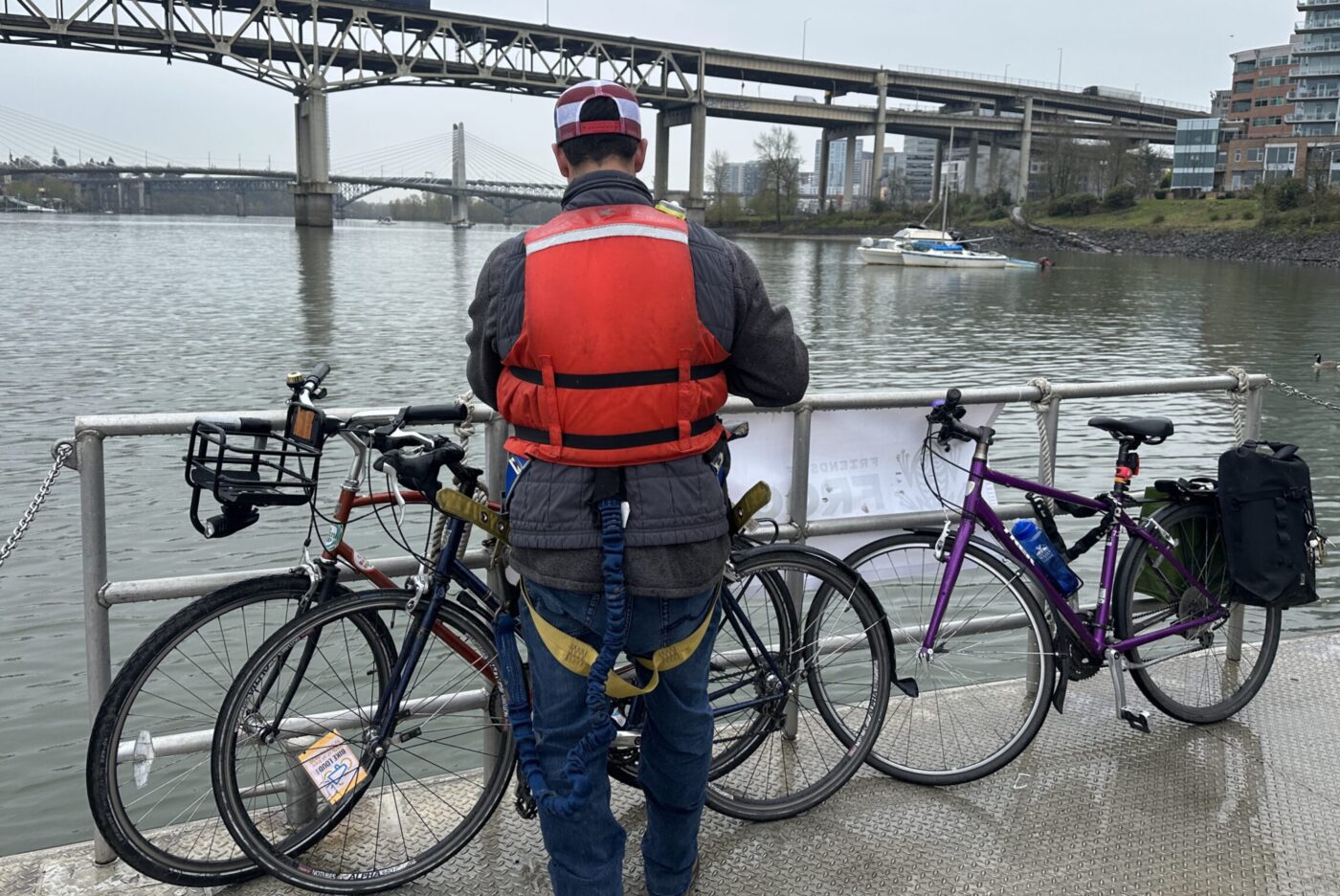
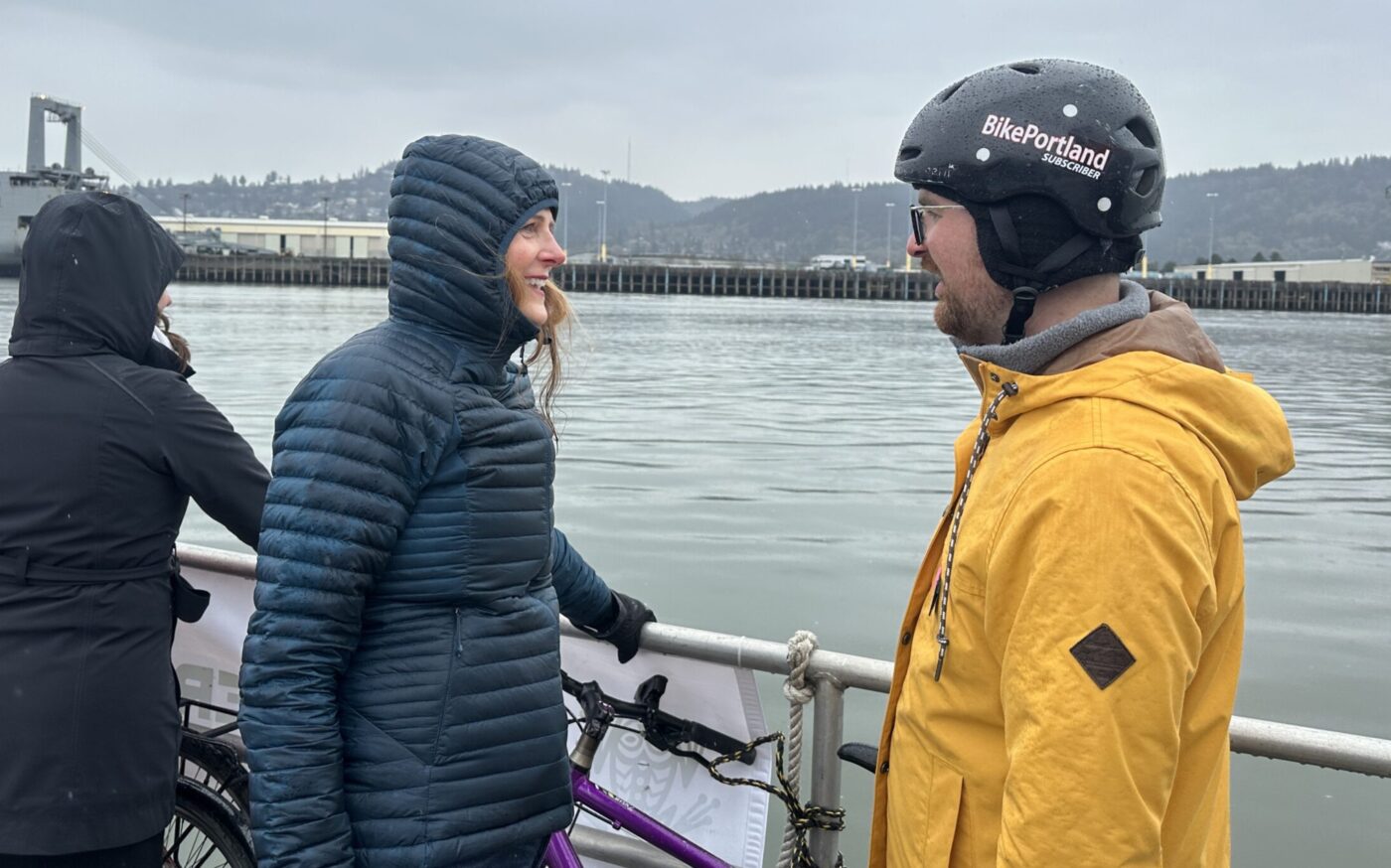
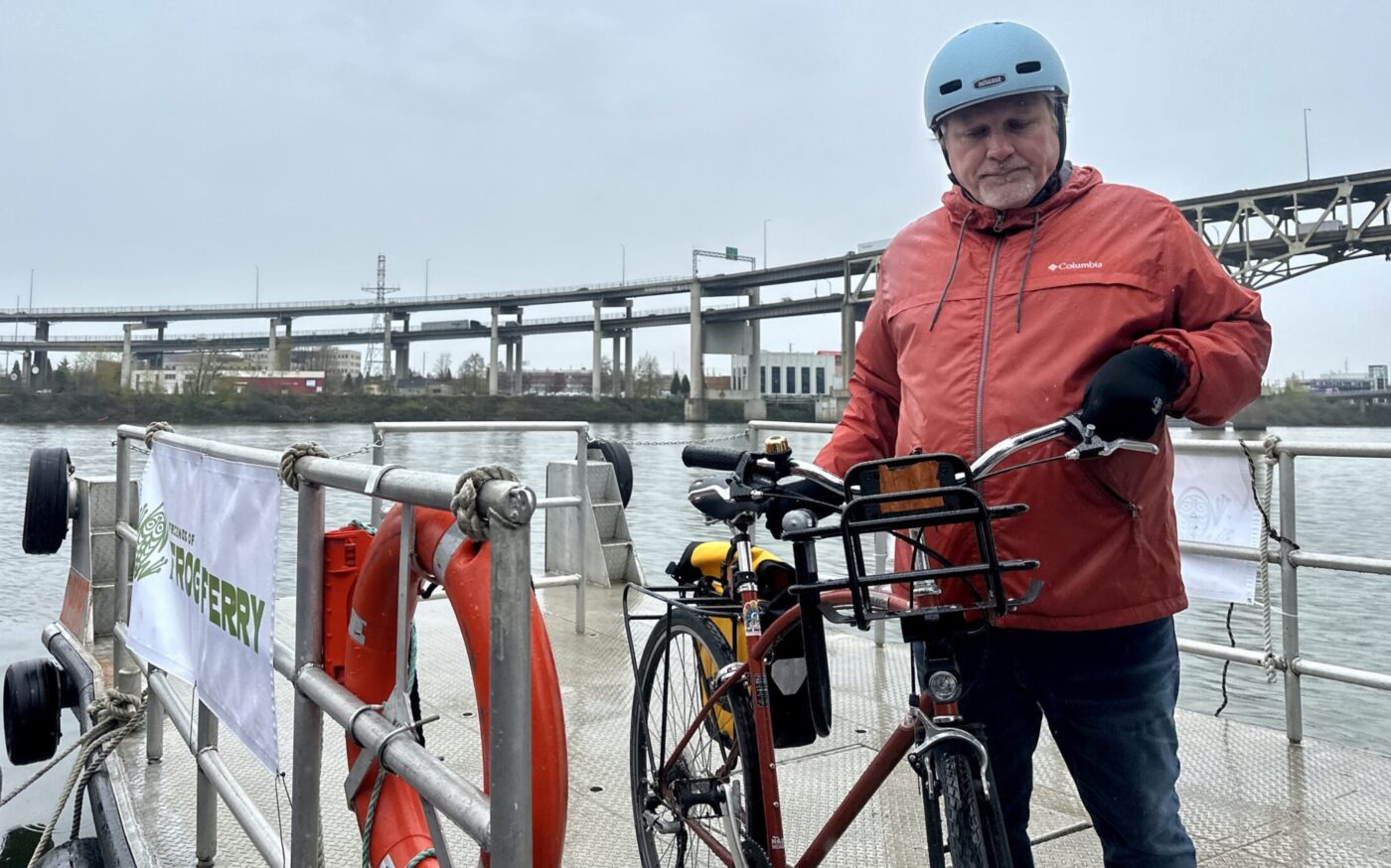
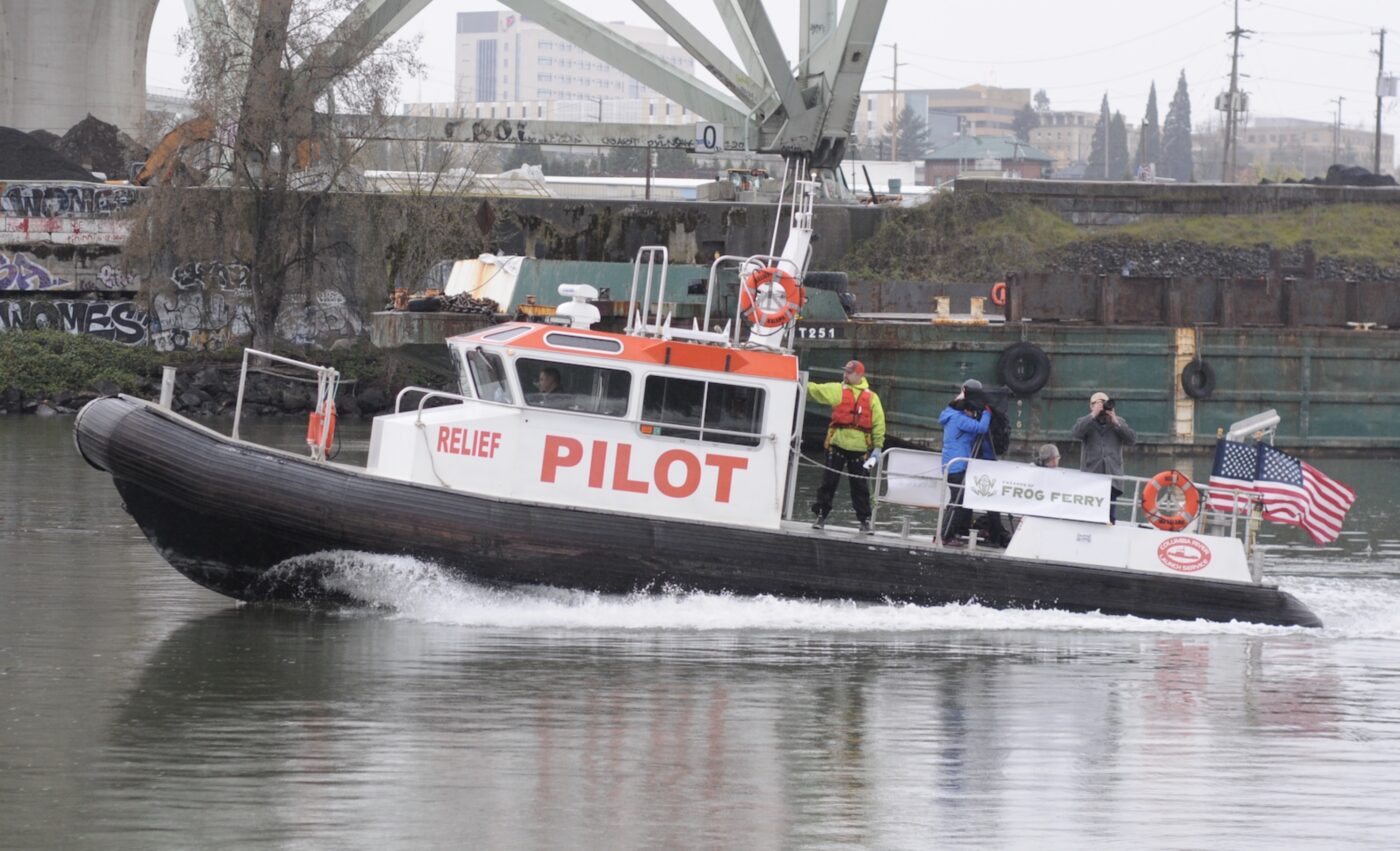


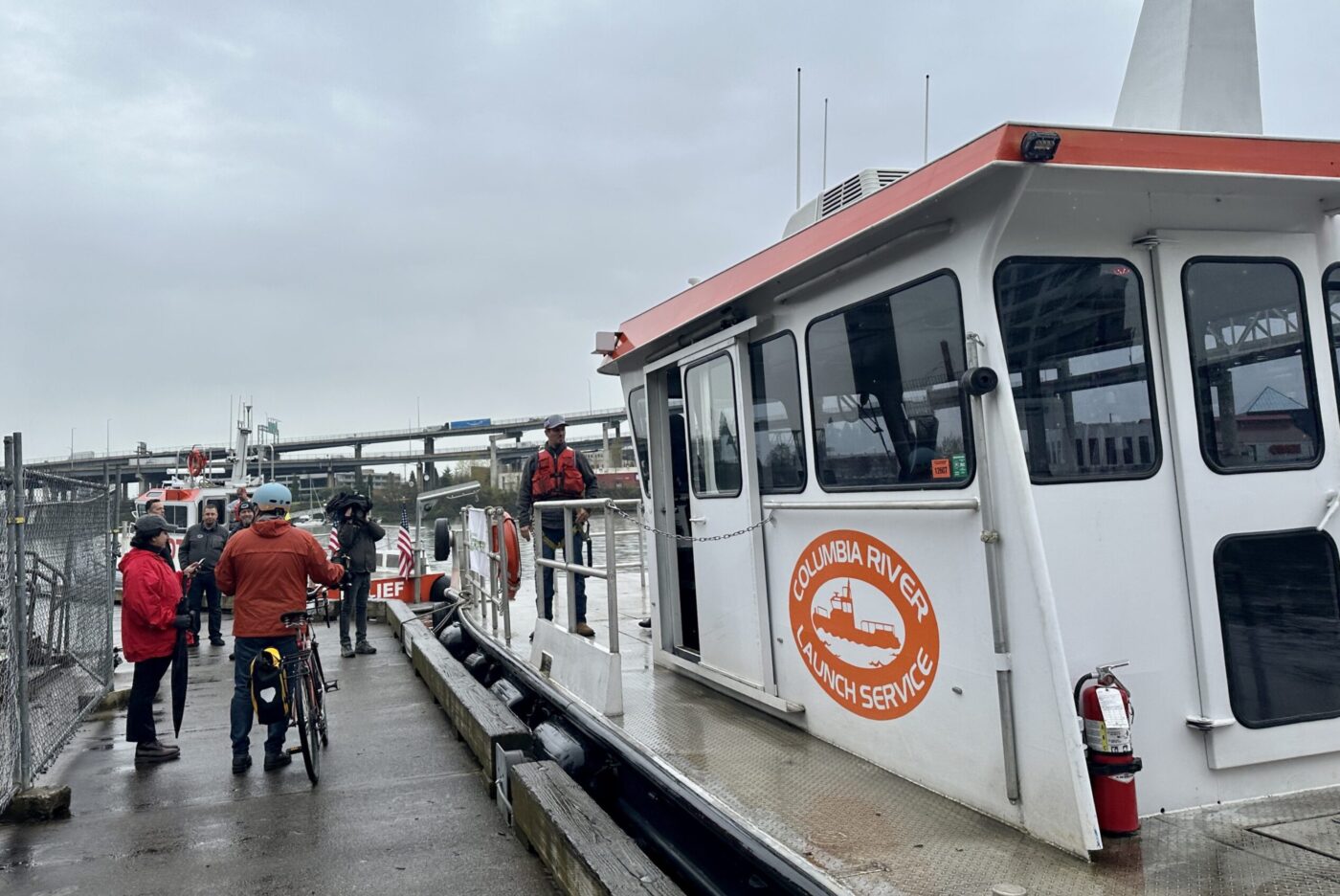
During the press conference, Bladholm and Byrd discussed how a ferry service would be able to revitalize downtown Portland. They also discussed its potential to add to Portland’s multimodal transportation network, specifically pointing out that the ferries would have room for bikes on board.
To underscore this point, Bladholm encouraged me to bring my bike onboard the vessel today. I wasn’t the only one: BikeLoud PDX Chair Kiel Johnson and Friends of the Green Loop Executive Director Keith Jones joined the boat trip, and they carried their bikes along as well. Once we were aboard, one of the captains helped us tie our bikes to the rails of the boat. They were secured snugly, but I imagine there would be a way to secure bikes on the real Frog Ferries that doesn’t require riders to be experts in maritime knot tying.
The boat trip itself was invigorating — more invigorating than you’d probably prefer for a daily commute, but passengers wouldn’t be out on the bow to face the elements on the real Frog Ferries if they’re built. We didn’t go all the way up to Cathedral Park (the boat turned around just short of Swan Island), but I was surprised how quickly we got there. The Frog Ferry plan calls for 25 minute trips between St. Johns and the South Waterfront going 24 knots (about 25 miles per hour). In a larger vessel, this speed would probably feel less thrilling, but on the small pilot boat, it felt like we were going a lot faster.
“The ferry docks have the potential to become real biking hubs.”
– Kiel Johnson, BikeLoud PDX
While this experience was an effective tactic from FOFF to convince people that traveling by water might not be a completely ridiculous idea, many Portlanders still scoff the idea of floating transit.
So, what’s stopping folks from embracing the idea? Johnson and Jones both stand out amongst their peers in Portland’s current transportation advocacy circles because of their support for the project. While others have criticized the idea as too flashy and unrealistic — No More Freeways co-founder and transportation data cruncher Joe Cortright called the proposal a “slow boat to nowhere” — Johnson and Jones think the city should give it a shot.
“I’m supportive of any active transportation project,” Jones told me, adding that he and Bladholm have spoken about how to connect the ferry service to the Green Loop plan that Jones is a primary booster for.
Johnson said that people were also skeptical of other big transportation projects, like the streetcar and aerial tram at Oregon Health and Sciences University, before they came to fruition. Johnson founded the bike valet at the base of the aerial tram and built it into North America’s largest, so he knows a thing or two about turning big ideas into big successes.
“The ferry docks have the potential to become real biking hubs,” Johnson said.
Bladholm said the money used to get the ferry off the ground wouldn’t take away from other active transportation projects. The federal grants FOFF would apply for are reserved specifically for ferry service, so she said we might as well use it for Portland.
“We just have to get people out of cars, however we do it,” she added.
Even if the relationship between ferry proponents and Portland officials is friendlier now, that doesn’t mean the city has the money to spare for an initial investment in the project. Shannon Carney, PBOT Commissioner Mingus Mapps’ transportation liaison, took a ride on the river later in the morning. She told me even though Mapps is a fan of the ferry, he would not be asking City Council to carve out money for the ferry in the Fiscal Year 2023-2024 budget. Instead, they’re going to take a different approach to funding.
“Commissioner Mapps is a Frog Ferry champion and supporter of the project, but it’s a challenging budget year for the city and for PBOT,” Carney said. “He’s working through the process of ensuring that Frog Ferry can be part of the Regional Transportation Plan (RTP), which is critical to receiving federal funding for it.”
As PBOT Commissioner, Mapps has a seat on the Metro Joint Policy Advisory Committee on Transportation (JPACT), the body that helps craft the RTP project list. A draft version of that list shared at their meeting Thursday morning (below) includes a $12 million line-item for a “passenger ferry pilot” that would be built with support from the Federal Transit Administration’s Passenger Ferry Grant Program.

Regardless of your position on this project, there’s something very alluring about being on the water. It’s a whole different world out there. It’s hard to tell from the shore, but there’s a lot of action taking place on the Willamette, and it was cool to feel like a part of that community, even if just for a bit. Even though I see the river almost every day, I’ve never really thought about being out on it like this.
Others felt similarly.
“One of the things I love about biking is the different perspective it provides. This will provide a new perspective of the city,” Johnson said.
It’s very possible that my positive experience on the boat this morning doesn’t mean Portland needs a ferry service, just that I should learn how to sail. Ultimately, it will be up to Portland City Council to make that decision. And with Mapps solidly behind it, that might happen sooner than we think.
If Frog Ferry receives a federal grant, Bladholm says the first one could be on the water as early 2025.


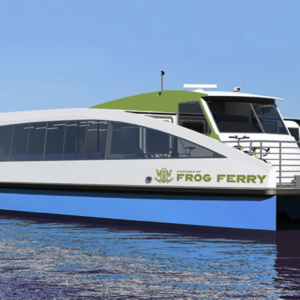
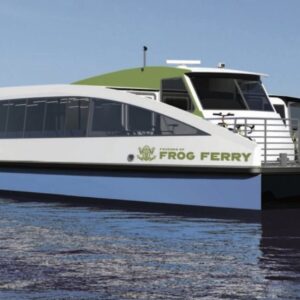
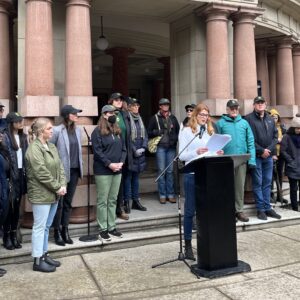
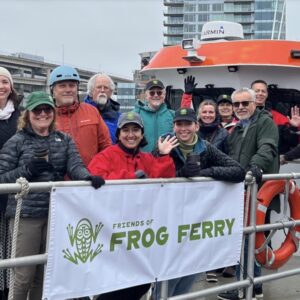
Thanks for reading.
BikePortland has served this community with independent community journalism since 2005. We rely on subscriptions from readers like you to survive. Your financial support is vital in keeping this valuable resource alive and well.
Please subscribe today to strengthen and expand our work.
Did you ask how many gallons of fuel it took for this trip?
It’s common for small boats to burn 1 gallon of fuel per mile.
This study by CSU Long Beach finds that passenger miles per gallon of diesel ranged from a high of 49 passenger-miles/gallon for the huge Staten Island Ferry in New York City to a low of 2.6 passenger-miles/gallon for large ferries in New Orleans. In San Francisco across the Golden Gate from Marin County, ferries average 14 passenger-miles per gallon, while private cars beat that with 24 mph, but the buses across the bridge get 9 times the efficiency: 217 passenger-miles per gallon. If the buses were given exclusive transit lanes in each direction for the entire trip (a big lift politically, but technically not very expensive) they would be faster for most trips: https://res.mdpi.com/d_attachment/energies/energies-04-00239/article_deploy/energies-04-00239.pdf
The Froggy Friends will just hand wave and say “oh, but it will run on biodiesel… and we’re studying electric options”.
Sounds like TriMet. Meanwhile, other municipalities have been transitioning to electric for some time (first via hybrids and now full electric).
The problem with the entire concept is transfer penalties. Neither end of the route will be conveniently located for most potential riders. You need to get there first, and if you’re on transit there will be a long walk to the boat, and then a wait for the boat to leave. There’s also the need to maneuver the boat up to the dock and moor it at each end, and then the deboarding time (likely a single-file line).
This isn’t a 25 minute trip. The trip will be [time it takes to get from home to St. Johns] + [time it takes to walk to the dock and board the ferry] + [time sitting on the ferry waiting for it to leave] + [25 minutes] + [time to dock and moor the ferry downtown] + [time standing in line to deboard] + [time to walk or walk/bus to your downtown destination] minutes long.
If you bring your bike, it’ll probably go faster at each end. But Google Maps says it’s a 45 minute bike ride from Cathedral Park to Waterfront Park, and it’s probably faster with one of them new-fangled electric bikes. So with the delays built into each end of the trip, it’s probably close to a wash for an acoustic bike. It’s likely faster to e-bike all the way.
I don’t doubt that the ferry ride itself would be much more enjoyable than a bus. But as transit, the bus will get you from home to wherever you’re going a LOT quicker.
A limited stop bus service (like the FX on Division) would get folks from downtown St. Johns (where people actually live) to central downtown (where people actually work) in 20-25 minutes using a small fraction of the fuel needed to move the same number of passengers on that boat.
This is interesting. Instead of St.Johns to South Waterfront, would service between South Waterfront and Lake Oswego, Oregon City, and Milwaukie reduce car trips from those suburbs and have a greater impact?
I have wanted to see the old rail line between Lake Oswego and Portland turned into a MUP or used as commuter rail again for years. With our homeless crisis, the MUP idea is clearly out as it would likely become another encampment. A ferry service might be very useful for multi-modal commuters.
I think there would only marginal benefits for going as far as Oregon City. It’s going to be too slow relative to driving. But the Lake O-Milwaukie leg actual would have a fair amount of utility, since there is no good way between them right now. I realize it’s not a huge origin/destination pair, but at least it would be the best option time-wise.
Other than that, the actual transportation utility of a ferry is just so limited in Portland. There are already too many better options for driving and even public transit.
I live in Milwaukie and it’s a real bummer that there’s not more direct way to get to Lake O than to go up to Sellwood and then back down.
We need a bridge, but it seem unlikely to happen soon- the areas of greatest economic activity are not opposite each other on the river. Maybe a ferry would be be more sensible?
If FOFF wants to use federal funding to run a tourist boat for a couple of years until the federal funding runs out, go nuts I guess. As long as no city/county/state funding is wasted on this I don’t see the harm.
Hell, if they bundled it with plans to complete the North Willamette Greenway or funds to promote redevelopment of the Cathederal Park brownfields, that would be great. Maybe we could could come up with a trendy name for it.
My bigger concern is that PBOT might look at this project as somehow addressing the peninsulas terrible public transportation. We need connections to locations on the east bank of the Willamette, where actual things are. We’ve built an entire public transportation network that is aimed at taking people places somewhere they don’t want or need to go (downtown), slowly.
Does FOFF have a public estimate of time onboard for the upstream journey?
Depends on the tide and water flow, but it would probably only add a couple of minutes to most trip times. Looking back at the last 12 months of data, the river flow the Morrison bridge is up to 3 ft/s (2 mph) downstream with the river is running fast, and at those times there is little variation with the tides. But when the river is low the incoming tide can actually reverse the average flow. On average the river is moving around 1mph. But this does not account for variation between the surface and deep water, or the center channel vs the sides, so the real variation could be greater. https://waterdata.usgs.gov/monitoring-location/14211720/#parameterCode=72255&period=P30D
I would be more concerned about he risk that ferry runs would have to be cancelled entirely due to high water, debris from heavy rains, high wind conditions, security reasons for the Navy fleet week, & etc. – while buses are sometimes cancelled due to freezing rain or snow, they are not affected by wind, rain or river flood levels.
Over my 25 years working on Swan Island I walked along the River almost every day, but only a time or two got out on the water. A commute via ferry does have its charm, and note that this demo ride just went as far as Swan Island…where incidentally over 10K folks work! Daimler HQ is right on the River. Live in South Waterfront; work on Swan Island. Ride a river ferry to work every day…sounds tempting. But for getting to Vancouver? Let’s get MAX across the Columbia for that.
Vancouver BC has a bunch of small ferries that connect across False Creek- they are super cool and fairly well-used. The difference between Vancouver and Portland is the level of waterfront development. IMO, the ferries in Portland would be useful as quick shuttles across the river, but for that be needed, we will need to remove I-5 from the east riverbank. Portland is still too poorly connected to the river for a ferry to make sense, although am excited by the idea that a ferry could become the catalyst to promote better connections.
Yeah MUCH different in Vancouver, BC. It’s like a 3-4 minute crossing across False Creek, not the long trip being proposed here.
At a minimum, such a water bus / ferry system should be seen as a resiliency system running now and thus available to be placed into backbone foot ferry service during a crisis (earthquake takes down a bridge – pick any one not built in last 20 years)…plus building a series of emergency docks now. [Otherwise the time it would take to build a new ferry in a crisis would take longer than building a new repaired bridge most likely.]
Having been in involved in Cascadia Rising planning in the mid 2000’s I don’t think public funds cost of maintaining a ferry that won’t do much good in the now (except provide employment for the top few people of course) just in case there is a disaster in the future when it won’t do much good then is worth it. Just saying the money is already available for ferries doesn’t mean it should come here.
This article almost made me think that this idea just might be feasible until I went back and read Hardesty’s objections and Cortrights opinion and it’s pretty clear what a Grift this is.
Non transparent, no real numbers, she isn’t upfront about her salary and spending….
If she thinks this idea is feasible (I think it might have Tourist appeal), find investors like everyone else with a business plan.
“…the RTP project list. A draft version of that list shared at their meeting Thursday morning (below) includes a $12 million request for a “passenger ferry pilot” that would be built with support from the Federal Transit Administration’s Passenger Ferry Grant Program.”
Point of clarification: Inclusion in the RTP project list is not a request for funding nor a guarantee that a project will be funded or built. It simply allows a project sponsor to apply for federal funds.
So if FF winds up in the RTP constrained list, there would still be several more steps in the process for this to be funded. Not the least of which would be to compete well enough to actually win a federal grant.
thanks. I realize I need to clean up that language. I will do it now.
Appear to be more of a job creation plan for Susan Bladholm and her board than a needed and pracitcal transportation option.
Every article about the Frog Ferry should be required to link to this excellent analysis by Joe Cortright:
https://cityobservatory.org/frog_ferry_slow_boat/
We need to kill this thing dead before they can steal any city money and dump it in the river.
Thanks for posting that. It’s great. What I especially like is that he discusses the wakes it would create. That’s why I especially hate the idea of it running south to L.O. or elsewhere. Much of the river south of downtown has sensitive natural areas on its banks, and is typically narrow. The ferry is justifying its value by promising trip times that would require speeds far higher than what’s possible without generating damaging boat wakes.
It’s also the stretch of river favored by kayakers, standup paddleboarders, sailboats and anglers. The last thing they need is heavy ferry wakes in their midst. And in fact, state boating laws require vessels to manage their wakes and their course to reduce impacts on other river users. That means the ferry MUST slow down, because the river is too narrow to avoid passing closely to other river users. The promoters are ignoring or concealing all of that.
The speed they went at on this little outing will not work and is illegal except in small lanes and sections of the river.
25mph with this ferry would cause huge wakes, not acceptable, and FOFF knows it which is just more reason to question the whole non profit BS that is going on.
Yes, remove I-5 from the east bank of the River! More than a few times I have pointed out that Frankfurt a. M. has a dozen museums along the Main River opposite the central city while Portland has a dozen lanes of traffic. Sad.
But at least the River is mostly clean now, and there are a few good points of access…South Waterfront, Riverplace, OMSI, the floating Esplanade, the Swan Island Willamettee Greenway Trail and so on. Some have residents nearby while others are close to employment centers. Something could work here.
Here is a much better use for a pedestrian/cyclist ferry:
Extend the Yellow Line to Hayden Island and run a pair of criss-crossing ferries to a CTRAN dock in Vancouver. It is only a half-mile; crossings and intervals could be 10 minutes or less.
Much more practical, popular, pleasant, as well as faster and cheaper than having to climb a high, dark, loud, monster bridge in dangerous proximity to queens/kings of the roads in their vicious chariots.
And no need for MAX in Vancouver!
The phrase “high, dark, loud, monster bridge” suggests you’re talking about ODOT’s planned megaproject.
But there’s already a perfectly good bridge there. Why replace it with a ferry? All ODOT needs to do is leave it there instead of tearing it out.
I rode the Staten Island Ferry when I lived in NYC. It was fun.
Th Frog Ferry sounds like a fun tourist excursion sounds like fun, too, but seems really impractical. Maybe in an alternate universe in which 2020 never happened to Portland (no Covid, no fires, no plywood, etc) there would be such awful traffic downtown that people would seek out alternatives to driving.
But that world does not exist!
If they’re so confident people will love the ferry, they should do a Kickstarter or GoFundMe for the initial pilot. No public funding should be spent on this enterprise until it manages to prove itself, because it’s very speculative and could easily be a failure.
IMO this is a project undeserving of local taxpayer funds. If the feds and the Oregon and Washington Tourist Boards want to fund this frivolity that’s fine…but I don’t want to be asked to pay a dime for it. And we all know that day will come.